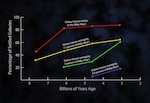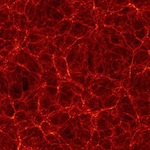Word doc
PDF (formatted and ready to go as a single newsletter page)
Discovered: Stellar Dinosaurs!

“We had no idea what these things were,” recounted D. Andrew Howell, staff scientist at Las Cumbres Observatory Global Telescope Network and adjunct assistant professor at UC Santa Barbara.
In 2006 and 2007, two objects caught by the detectors of the Supernova Legacy Survey looked like supernovae—stars exploding in cataclysmic stellar suicide—but did not act like familiar supernovae. Instead of brightening over a period of maybe three weeks (about 20 days), they seemed to take nearly three months (about 80 days). At first, no host galaxy could be found, so Howell and his colleagues didn’t know “even whether they were supernovae or whether they were in our galaxy or a distant one.” And when their visible light was spread out into a rainbow, their spectra revealed mysterious broad lines never seen before.
Over the next year or so, a handful of similar objects discovered by the Palomar Transient Factory and the Texas Supernova Search revealed that they actually were incredibly distant supernovae—ones dating from beyond a redshift of z = 1, that is, more than halfway back to the Big Bang. The mysterious lines in the visible spectra were actually ultraviolet emission redshifted—their short UV wavelengths expanded by the expanding universe—into the longer visible region of the electromagnetic spectrum.
Indeed, the supernovae were so distant that not only was light expanded in wavelength, but also time was dilated or expanded (per Einstein’s theory of relativity). That time dilation stretched out the duration of the event so that, as seen from telescopes on Earth, the explosions seemed to unfold in slow motion.
But another big mystery remained: how could those supernovae be so phenomenally brilliant?
Power source?
Supernovae are not alike. For decades, astronomers had known that supernovae fell into different types based on their light curves, that is, their pattern of rising and falling brightness. Later, they found these types actually corresponded to different physical circumstances triggering the explosions. Even those types have fine distinctions based on their spectra, giving rise to the categorization of supernovae by roman numerals, with sub-classes given lower-case letters. For example, Type Ia supernovae originate from white dwarfs in binary star systems, whereas Type II supernovae originate in an implosion-explosion event when a massive star’s core collapses and the star blows off its outer layers.
But the new supernovae did not correspond to any known type. Moreover, based on their distances, they had to be extraordinarily energetic. Their luminosity was roughly “10 times brighter than a thermonuclear [Type Ia] and 100 times brighter than a typical core-collapse supernova,” state Howell and his 17 co-authors in a paper published in the December 20, 2013 issue of The Astrophysical Journal.
For help in understanding the observations, Howell turned to computational astrophysicist Daniel Kasen, UC Berkeley and the Lawrence Berkeley National Laboratory, to see whether computer simulations could shed light on physics that could produce such unimaginable energies.
Hydrogen-free superluminous?
The simulations suggested that one object, designated SNLS 06D4eu, was “unlike a traditional core-collapse, thermonuclear or interaction-powered supernova.” Instead, it resembled an emerging class of supernovae classed as superluminous supernovae, a handful of which have been discovered.
The data suggest a star originally 20 to 40 times more massive than the sun first blew off its outer hydrogen-rich layers. Then the dense naked core— still having a mass five times that of the sun and composed of carbon, oxygen, and other heavy elements—precipitously collapsed into a highly magnetized neutron star only tens of miles across, spinning hundreds of times per second, triggering the super-energetic explosion. In short, SNLS 06D4eu is one of a new sub-class of hydrogen-free superluminous supernovae.
“As the most distant superluminous supernova with a spectrum (z = 1.588), SNLS 06D4eu provides a rare glimpse of the chemical composition and lightcurve evolution of an early-universe supernova,” write Howell and Kasen, and coauthors. It is also one of the most luminous supernovae known. Thus, they conclude, “it could be a relic of an earlier form of supernovae that is all but extinct today.”
“These are the dinosaurs of supernovae!” Howell exclaimed. SNLS 06D4eu exploded before the sun was even born, when the universe was only 4 billion years old. “We were lucky to be pointing telescopes in the right direction when the photons hit Earth after their 10-billion-year journey.”
–Trudy E. Bell, M.A.
Further reading: The paper “Two superluminous supernovae from the early universe discovered by the Supernova Legacy Survey”—which, by the way, reads like a scientific detective story in detailing the discovery and sleuthing—is at http://arxiv.org/abs/1310.0470. A UC Santa Barbara press release is at http://www.news.ucsb.edu/2013/013826/powerful-ancient-explosions-explain-new-class-supernovae . The Palomar Transient Survey is described in the earlier UC-HiPACC AstroShort “Stars That Go BANG!” at http://hipacc.ucsc.edu/AstroShorts/February2012AstroShort.html .
The University of California High-Performance AstroComputing Center (UC-HIPACC), based at the University of California, Santa Cruz, is a consortium of nine University of California campuses and three Department of Energy laboratories (Lawrence Berkeley Laboratory, Lawrence Livermore Laboratory, and Los Alamos National Laboratory). UC-HiPACC fosters collaborations among researchers at the various sites by offering travel and other grants, co-sponsoring conferences, and drawing attention to the world-class resources for computational astronomy within the University of California system. More information appears at http://hipacc.ucsc.edu .




















